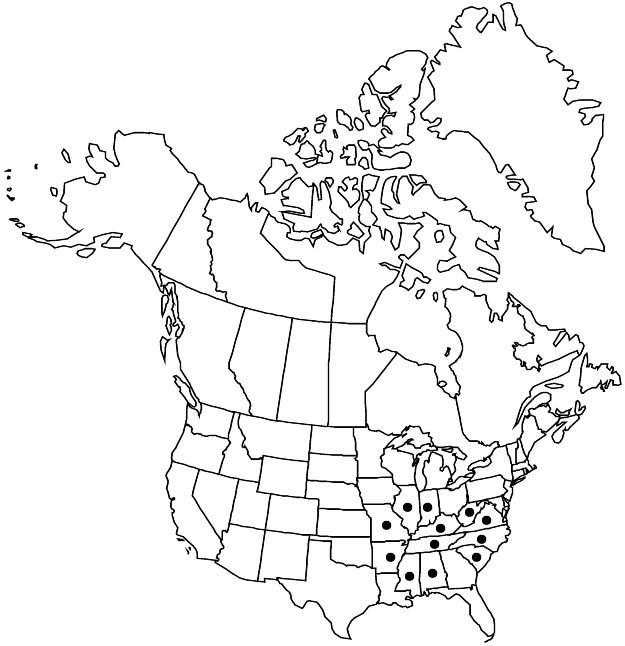Difference between revisions of "Heuchera parviflora"
Index Seminum (Göttingen) 1838: 4. 1838 ,.
FNA>Volume Importer |
FNA>Volume Importer |
||
| Line 21: | Line 21: | ||
|distribution=United States. | |distribution=United States. | ||
|discussion=<p>Varieties 2 (2 in the flora).</p><!-- | |discussion=<p>Varieties 2 (2 in the flora).</p><!-- | ||
| − | --><p>The specific epithet, parviflora, is similar to that of another species, Heuchera parvifolia, but these two species are distinct and have different legitimate names. The varieties of H. parviflora are not sympatric. The species merits phylogenetic study. The Blackfoot Indians applied a poultice of the pounded root to sores and swellings (D. E. Moerman 1998).</p> | + | --><p>The specific epithet, parviflora, is similar to that of another species, <i>Heuchera parvifolia</i>, but these two species are distinct and have different legitimate names. The varieties of <i>H. parviflora</i> are not sympatric. The species merits phylogenetic study. The Blackfoot Indians applied a poultice of the pounded root to sores and swellings (D. E. Moerman 1998).</p> |
|tables= | |tables= | ||
|references= | |references= | ||
| Line 56: | Line 56: | ||
|publication year= | |publication year= | ||
|special status= | |special status= | ||
| − | |source xml=https://jpend@bitbucket.org/aafc-mbb/fna-data-curation.git/src/ | + | |source xml=https://jpend@bitbucket.org/aafc-mbb/fna-data-curation.git/src/8f726806613d60c220dc4493de13607dd3150896/coarse_grained_fna_xml/V8/V8_168.xml |
|genus=Heuchera | |genus=Heuchera | ||
|species=Heuchera parviflora | |species=Heuchera parviflora | ||
Revision as of 18:04, 18 September 2019
Herbs acaulescent; caudex branched or unbranched. Flowering stems 9–45 cm, short to long stipitate-glandular, viscid. Leaves: petiole usually long stipitate-glandular, sometimes short stipitate-glandular; blade (often purple abaxially), reniform to orbiculate, shallowly 5–7-lobed, 3–13 cm, base cordate, lobes rounded, margins crenate, apex obtuse, surfaces short or long stipitate-glandular abaxially, short stipitate-glandular adaxially, viscid. Inflorescences diffuse. Flowers: hypanthium radially symmetric, free to 0.3 mm, white or pink, obconic, 1.2–3.2 mm, short or moderately long stipitate-glandular; sepals erect, green-tipped, equal, 0.5–1.3 mm, apex rounded; petals reflexed, white or pink, narrowly oblanceolate, unlobed, 1.5–3.5 mm, margins entire; stamens exserted 1.2–3.2 mm; styles exserted 1–3 mm, 1.5–4 mm, to 0.1 mm diam. Capsules ovoid, 2–5.7 mm, (minutely stipitate-glandular or glabrous), beaks divergent, not papillose. Seeds dark brown, ovoid, 0.4–0.6 mm, smooth.
Distribution

United States.
Discussion
Varieties 2 (2 in the flora).
The specific epithet, parviflora, is similar to that of another species, Heuchera parvifolia, but these two species are distinct and have different legitimate names. The varieties of H. parviflora are not sympatric. The species merits phylogenetic study. The Blackfoot Indians applied a poultice of the pounded root to sores and swellings (D. E. Moerman 1998).
Selected References
None.
Key
| 1 | Petioles and hypanthia sparsely to densely long stipitate-glandular; leaf blades sparsely to densely long stipitate-glandular abaxially, hairs 0.7- 2.5 mm. | Heuchera parviflora var. parviflora |
| 1 | Petioles and hypanthia densely short stipitate- glandular; leaf blades densely short stipitate-glandular abaxially, hairs to 0.6 mm. | Heuchera parviflora var. puberula |